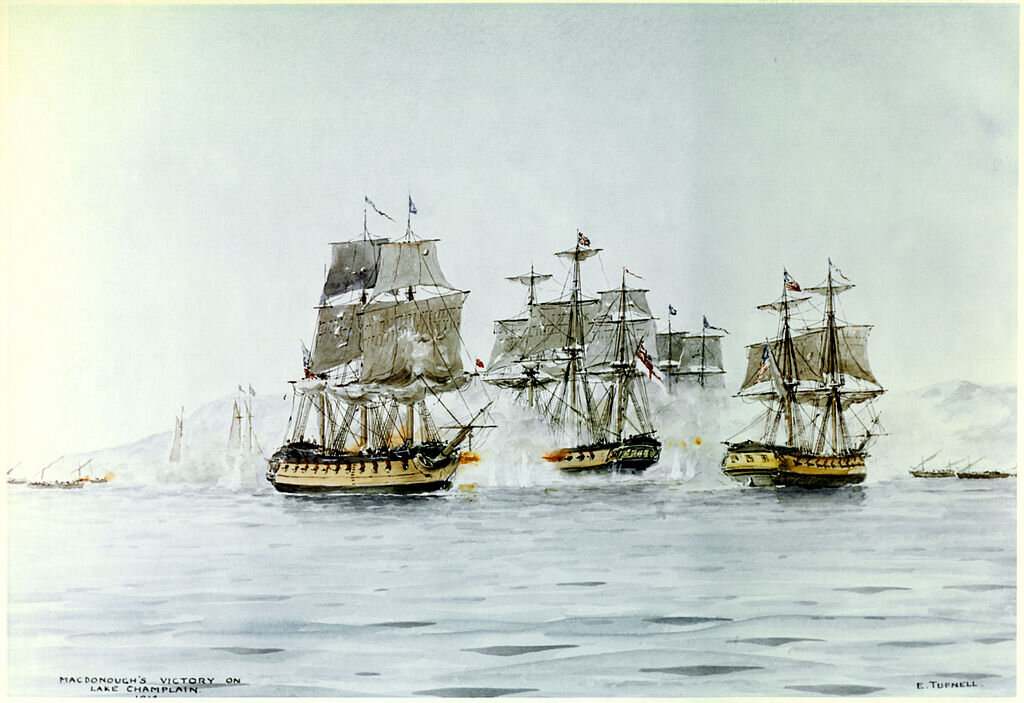The War of 1812 took place between the US and the UK from 1812 to 1815. There were many twists and turns in the war, and here Chuck Lyons tells us about the naval encounter at the Battle of Plattsburgh/Battle of Lake Champlain. This battle may have turned the course of the war.
The US Sloop Saratoga (left center) and the U.S. Brig Eagle (right) engaging the British flagship Confiance (center) off Plattsburg, New York, 11 September 1814. By Edward Tufnell.
In September 1814, twenty-seven months into the War of 1812, four British warships and a dozen gunboats sailed into Plattsburgh Bay at the northern end of Lake Champlain between New York State and Vermont. They were there to support an 11,000-strong army under General Sir George Prevost, an army that has been called “the strongest…that had ever been sent to North America,” and an army that intended to sever the new United States with a march on New York City.
In the battle that followed broadsides were fired at point blank range and gunboats exchanged fire within pistol shot of each other.
It would be a turning point of the War of 1812.
The opposing sides
The American ships were under the command of Lt. Thomas Macdonough, who was 28-years-old but had been in the Navy since he was sixteen, had fought with Stephen Decatur in the First Barbary War, and had been in command of Lake Champlain naval operations since October of 1812. The British force was under the command of newly-arrived Capt. George Downie, a twenty-year veteran of the British Navy.
Capt. Downie commanded the Confiance, a 1,200-ton frigate carrying thirty-seven guns, that was nearly double the size of the 734-ton American flagship Saratoga. She was accompanied by the sloops Linnet, Chubb, and Finch, as well as twelve gunboats, each carrying one or two guns. In all, the British had sixteen vessels. Opposing them would be America’s fourteen vessels.
Lt. Macdonough had retired to Plattsburg Bay to nullify the British superiority in long guns and was waiting in a north-south line when at about 9 a.m. Sept. 11, the British vessels rounded Cumberland Head on the eastern side of the bay firing blank charges to notify Prevost of their arrival
The battle was quickly on.
The battle
“The firing was terrific, fairly shaking the ground, and so rapid that it seemed to be one continuous roar, intermingling with spiteful flashing from the mouths of guns, and dense clouds of smoke soon hung over the two fleets,” wrote Julius Hubbell, who watched the battle from Cumberland Hill on the east side of the Bay.
Capt. Downie was killed in the first fifteen minutes of the fighting.
About 10:30 a.m. Lt. Robert Henley, commanding the American ship Eaglecut her cable and allowed his ship to drift south to the rear of Saratoga, which was now receiving fire from theLinnet and theConfiance. There he joined in firing on the latter with his undamaged port side guns.
By now nearly all the Saratoga’s starboard guns had been knocked out, and the ship had been set afire twice by hot shot from the Confiance. Finally, the single cannon left on the Saratoga’sstarboard side broke free and fell down the main hatch. Confiance by this time had only four port guns still operational. At this point, Lt. Macdonough let go his stern anchor, passed the hawser from one of the ship’s kedge anchors, which had been laid off Saratoga’s bow, under the bow and hauled to “wind ship” and bring the Saratoga’s thirteen undamaged port guns to bear on Confiance. Trying the same maneuver, but too badly damaged to execute it, the Confiancegot stuck halfway around leaving her stern open to the Saratoga’s guns.
Helpless,Confiancesurrendered at 11 a.m.
Lt. Macdonough then hauled again on the Saratoga’sanchor cable and turned her fury on the isolated Linnet. With water rising to as much as a foot above her lower deck, and the wounded in danger of drowning, the British brig struck her colors at 11:20 while USS Ticonderoga was finishing up its engagement with the British gunboats.Those gunboats that had not already dropped out of the fighting fled the scene.
None of the large vessels of either side had a mast left that would bear a sail.
The British had lost five officers, including Capt. Downie, forty-nine enlisted men killed and 116 wounded, a casualty rate of eighteen percent. The Americans suffered a casualty rate of thirteen percent with four officers and forty-eight men killed and another fifty-eight wounded.
Meanwhile on land the British and American forces had engaged in an artillery duel until word reached Gen. Prevost of the defeat of his naval support in the bay. Realizing there was no longer any reason for his assault and that Plattsburgh itself was no longer an objective, Provost called off the action and retreated north.
Five months later the war was over.
What do you think the impact of the Battle of Plattsburgh/Battle of Lake Champlain was on the War of 1812? Let us know below.







